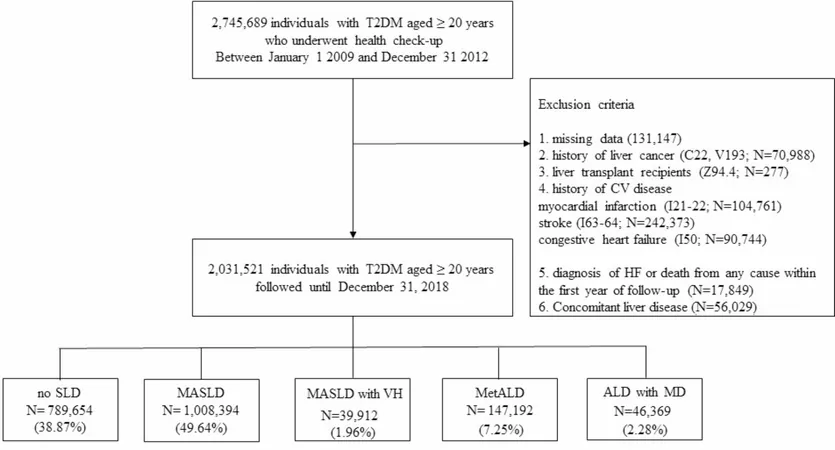
The Hidden Link Between Metabolic Dysfunction-Associated Steatotic Liver Disease and Heart Failure in Type 2 Diabetes Patients
2024-11-01
Author: Ming
Introduction
An alarming 462 million people worldwide are grappling with type 2 diabetes mellitus (T2DM), and projections indicate that this number could soar to 578 million by 2045. This chronic condition primarily stems from pancreatic beta-cell dysfunction and insulin resistance, with the latter leading to detrimental changes in the body's metabolic profile, including increased free fatty acids and low-density lipoprotein cholesterol. These alterations predispose T2DM patients to various metabolic disorders, such as hypertension, dyslipidemia, and liver conditions like steatotic liver disease (SLD)—a term that was recently updated to "metabolic dysfunction-associated steatotic liver disease" (MASLD).
Prevalence of Heart Failure in T2DM Patients
Recent studies highlight that heart failure (HF) is alarmingly prevalent among those with T2DM, affecting nearly 15% of this population. More than half of all deaths in T2DM patients can be linked to cardiovascular disease, making it imperative to address the potential predictors of cardiovascular risk in these individuals. The situation is growing increasingly serious as research indicates that the comorbidity of non-alcoholic fatty liver disease (NAFLD)—now recognized as MASLD—affects up to 50% of those with T2DM.
The Nationwide Cohort Study
Focusing on this critical intersection, a nationwide cohort study in South Korea assessed 2,031,521 adults aged 20 and over with T2DM, examining how different subtypes of liver disease impacted cardiovascular mortality and heart failure risk over time. Participants were classified based on various liver disease status, including MASLD and metabolic alcohol-associated liver disease (MetALD), among others.
Findings and Implications
The findings were enlightening: individuals with MASLD exhibited a 27% increased risk of cardiovascular mortality compared to those with no liver disease. Additionally, data suggested that mild alcohol consumption, paradoxically, was associated with a lower risk of new heart failure diagnosis, hinting at a J-shaped relationship between alcohol intake and cardiovascular risks. However, this risk drastically shifted in individuals consuming higher alcohol amounts, underlining the complexity of lifestyle factors at play.
Data and Analysis
This large-scale analysis benefited from data collected via the National Health Insurance Service, a comprehensive health database incorporating various health screening results, medical claims, and lifestyle factors. It illuminated not only the prevalence of liver disease among T2DM patients—reporting substantial proportions for MASLD and other types—but also revealed how essential lifestyle factors, demographic variables, and existing health conditions further complicate cardiovascular risk stratification in this demographic.
Key Takeaways
An important takeaway from the research emphasizes the influence of alcohol consumption on health outcomes, particularly the heightened risk associated with heavy drinking, in stark contrast to the reduced risks linked to moderate consumption. Moreover, the severity of liver disease, correlated with elevated fatty liver index scores, consistently predicted higher rates of both heart failure and cardiovascular mortality.
Conclusion
In conclusion, this comprehensive investigation reveals alarming connections between MASLD and increased risks of heart failure and cardiovascular mortality in patients with T2DM. The complexity of factors including alcohol use, metabolic syndrome components, and lifestyle choices, serves to underscore the need for tailored interventions to mitigate these risks. The well-documented prevalence of liver disease, particularly in T2DM patients, demands urgent attention. Effective strategies are crucial in managing these intertwined health issues to improve long-term outcomes and reduce mortality in a growing population at risk.





 Brasil (PT)
Brasil (PT)
 Canada (EN)
Canada (EN)
 Chile (ES)
Chile (ES)
 España (ES)
España (ES)
 France (FR)
France (FR)
 Hong Kong (EN)
Hong Kong (EN)
 Italia (IT)
Italia (IT)
 日本 (JA)
日本 (JA)
 Magyarország (HU)
Magyarország (HU)
 Norge (NO)
Norge (NO)
 Polska (PL)
Polska (PL)
 Schweiz (DE)
Schweiz (DE)
 Singapore (EN)
Singapore (EN)
 Sverige (SV)
Sverige (SV)
 Suomi (FI)
Suomi (FI)
 Türkiye (TR)
Türkiye (TR)